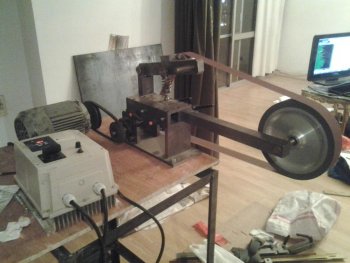Josh Dabney
Moderator
Here's my take on motor RPM
It doesn't matter , LOL Unless your going to run a direct drive set-up (no belt and pulleys with the drive wheel right on the motor shaft) In which case you WANT the fast motor.
I figured it like this- the less RPM's the motors turning the longer the bearings and windings will last. This is just my theory not based on any scientific study or facts so TIFWIW just my opinion.
The RPM of the driveshaft is all that matters so a lower rpm motor with pulleys increasing the driveshaft RPM = longer motor life (MAYBE) LOL.
To be honest the quality of the motor is most likely the biggest factor that will determine it's life.
Some things require great consideration and others are easily overthought and worried about. I think motors are easily overthought in the context we're talking about here.
Get the highest HP you can run and get the driveshaft turning 3450 RPM (or even a touch more ) and you'll have a great grinder that'll last a LONG time.
) and you'll have a great grinder that'll last a LONG time.
-Josh
It doesn't matter , LOL Unless your going to run a direct drive set-up (no belt and pulleys with the drive wheel right on the motor shaft) In which case you WANT the fast motor.
I figured it like this- the less RPM's the motors turning the longer the bearings and windings will last. This is just my theory not based on any scientific study or facts so TIFWIW just my opinion.
The RPM of the driveshaft is all that matters so a lower rpm motor with pulleys increasing the driveshaft RPM = longer motor life (MAYBE) LOL.
To be honest the quality of the motor is most likely the biggest factor that will determine it's life.
Some things require great consideration and others are easily overthought and worried about. I think motors are easily overthought in the context we're talking about here.
Get the highest HP you can run and get the driveshaft turning 3450 RPM (or even a touch more
-Josh

